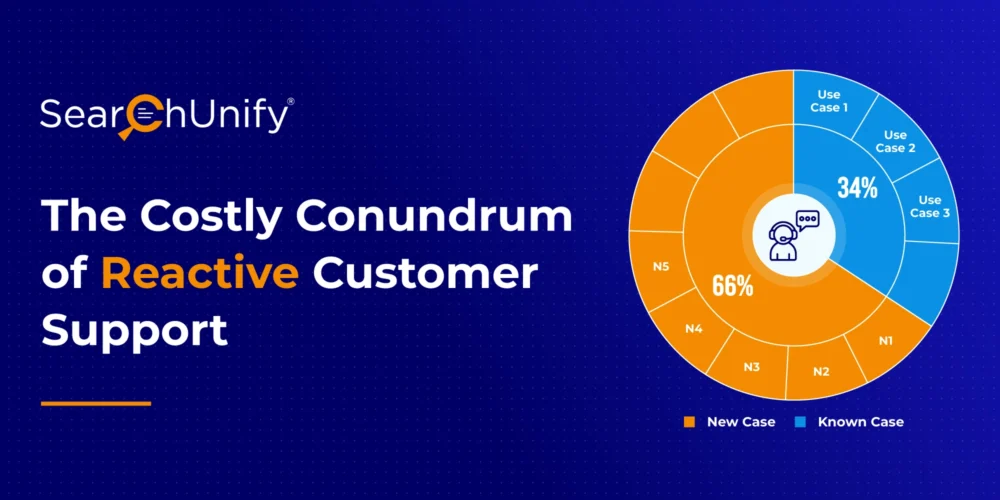
Imagine running a successful e-commerce business with an overflowing customer support inbox. Some inquiries are routine, but others reveal recurring issues that just won’t go away. Your dedicated support team is working tirelessly, but the sheer volume of requests threatens to engulf them. The result? Soaring costs, frustrated customers, and a relentless cycle of support chaos.
Yet, the complications don’t end there. Determining which support cases are genuinely new and which fall under the category of known issues is akin to navigating a labyrinth. These are some of the biggest pain points that reactive support creates that often leave businesses yearning for a more proactive approach.
In this blog post, we take a deep dive into the whirlwind world of reactive support. We’ll untangle its complexities and shine a light on the path to proactive support excellence—a path that promises smoother operations, happier customers, and a way out of the support maze. Let’s begin by understanding the difference between reactive and proactive support!
| Basis of Distinction | Reactive Support | Proactive Support |
| Customer Initiates | Customers reach out with issues when problems arise, often leading to delays in resolution. | Issues are identified and resolved before customers even notice them. |
| Issue Resolution Approach | Reactive responses to issues as they occur, which can result in slower issue resolution. | Proactively addressing and preventing issues, leading to faster resolution. |
| Resource Allocation | Resources are allocated reactively based on the volume of incoming issues. | Efficient allocation based on data and predictive analytics. |
| Knowledge Base Usage | Limited use of the knowledge base for self-service and problem prevention. | Extensive use of the knowledge base for self-service and problem prevention. |
| Cost Management | Escalating support costs due to high volume and delayed resolutions. | Extensive use of the knowledge base for self-service and problem prevention. |
Challenges in Adopting Proactive Support
To make the shift to proactive support, businesses must navigate a landscape of hurdles:
- Resource Misallocation: Organizations often struggle with allocating resources efficiently because they lack a clear understanding of which issues demand immediate attention and which can be handled proactively. This misallocation can lead to a waste of manpower and resources, as support teams may spend excessive time on known issues that could be automated or addressed systematically.
- Recurring Tickets: Organizations frequently grapple with recurring problems that erode customer satisfaction and escalate support costs. Without a systematic approach to identifying and addressing the root causes of these issues, they continue to resurface, frustrating both customers and support teams. Many organizations also lack the capability to predict future customer issues accurately, leaving them reactive rather than proactive in addressing problems.
- Underutilized Knowledge Base: Despite the presence of a knowledge base, its full potential remains untapped due to inadequate documentation of solutions for known issues. This shortfall translates into customers encountering difficulties in locating answers independently. Consequently, this not only hampers their self-service experience but also triggers an unnecessary influx of support requests, highlighting the pressing need for improved content findability within the knowledge base.
- Escalating Support Costs: Escalating support costs can be a significant challenge for organizations as they grapple with an increasing volume of reactive support requests. Without a proactive approach, support costs can spiral out of control, straining budgets and resources. Consider an IT services company grappling with escalating expenses as they consistently respond to urgent system failures instead of implementing preventive maintenance.
- Hiring More Agents: As above mentioned, insufficient documentation and subpar content findability make it difficult for customers to find answers independently. Consequently, businesses transitioning to proactive support may need to hire additional agents to meet the increased support demand. However, recruiting, training, and managing new talent come with their own challenges, including cost considerations and ensuring service quality consistency. For instance, a SaaS company experiencing a surge in customer inquiries due to poorly documented features may need to expand its support team to meet the demand.
If you’re contemplating the shift to proactive support, rest assured, we’ve got your back.
Unlocking Proactive Support Excellence with New vs. Known Case Analysis
The New vs. Known Case Analysis stands as a robust tool for organizations embarking on the journey toward proactive customer support. It doesn’t just categorize issues; it provides valuable context by distinguishing between ‘known’ issues with historical background and ‘new’ emerging problems.
This analytical approach empowers you to make informed decisions, strategically allocate resources, and tackle recurring issues at their core, thus preventing them from resurfacing. Moreover, it facilitates the development of predictive models, diminishing the need for reactive interventions and subsequently reducing support costs.
By enhancing your knowledge base, it transforms it into a prized self-service resource, reflecting your commitment to delivering exceptional support. Furthermore, it optimizes resource allocation, ensuring proactive efficiency that can benefit both your organization and your valued customers.
As we continue our exploration of support and service excellence, stay tuned for our upcoming blogs. We’ll delve deeper into strategies, best practices, and emerging trends that can further enhance your proactive support journey. Stay tuned!











